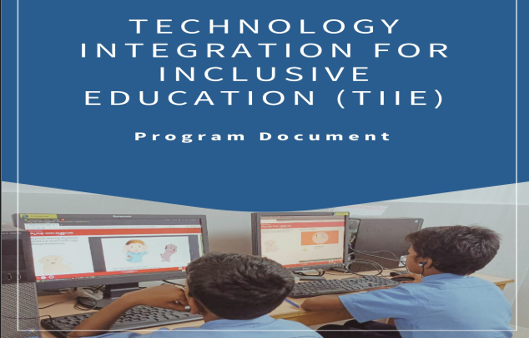The Technology Integration for Inclusive Education (TIIE) project was envisioned recognizing the need for inclusive approaches and strategies to address the learning needs of all students, including those with mild learning difficulties. The project also aimed to explore ways in which technology can be meaningfully integrated into the classroom.
Students in grades 6-9 in government and government-aided schools in Bengaluru, Karnataka, along with teachers, headmistresses, cluster resource persons (CRPs), block resource persons (BRPs), and block inclusive education resource teachers (BIERTs) were engaged in the project from April 2022 until March 2023. Students were engaged through intensive weekly interactions in higher primary schools, and through camps in high schools. Modules for intensive engagement were developed based on a baseline study that highlighted the need to focus on foundational mathematics and language skills. The module for the event-based engagement largely focused on science processing skills.
The Universal Design for Learning (UDL) framework – which offers concrete suggestions to ensure all students are able to meaningfully participate in the learning process – guided the TIIE project design and implementation. Furthermore, digital tools such as a Language Lab (developed as part of the project), PhET, GeoGebra, and TuxMath were also integrated into the project.
An analysis of the baseline and endline findings, as well as the feedback from teachers and students, indicated that the project contributed to significantly improving students’ competencies in mathematics and languages, as well as their engagement with learning, and their attitudes towards peers. From our interactions with different stakeholders of the education system, several challenges were identified vis-à-vis making schools inclusive, and the following are some recommendations, based on our learnings, for inclusive approaches:
- Capacity-building programs should be conducted for all teachers and teacher-educators (BIERTs, BRPs, and CRPs) that focus on the need and importance of inclusive education (IE). These programs must include sensitization to learning disabilities and means of identifying them, and awareness about the UDL framework and how it can be incorporated as part of the teaching-learning process. Differentiated instruction – incorporating multilevel, multilingual, multimodal, and multisensory resources – needs to be the default approach.
- Given that a large proportion of classrooms, especially in urban areas and in border geographies, are linguistically diverse, capacity building focusing on ‘multilingual teaching approaches must be a part of teacher professional development (TPD) programs.
- BRPs, CRPs, and BIERTs should be prepared to offer meaningful academic support to teachers, in addition to administrative support.
- Coordination between the education and the public health departments should be enhanced to ensure that the facilities and resources available for Children with Special Needs (CWSN) reaches them.
- Policy-level changes are necessary to ensure that teacher vacancies are filled in all schools and adequate time is provided to teachers for academic planning and activities.
- All schools have some gaps with respect to the minimum physical and academic infrastructure defined in the Right to Education (RTE) Act. Since the RTE Act recognizes these facilities as a part of the fundamental right of each child, it is essential that all the gaps be filled in a time-bound manner. This will ensure schools can provide IE, as well as encourage parents to move their children from private to government schools.

